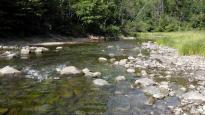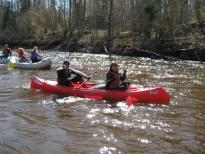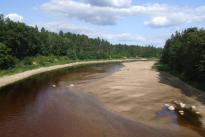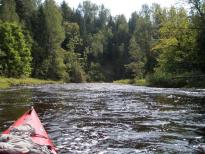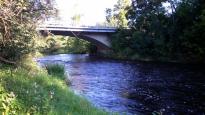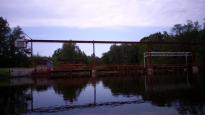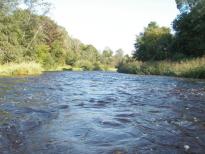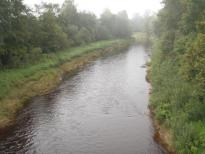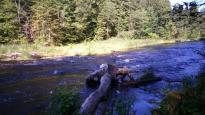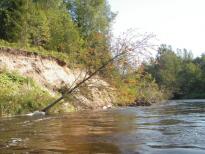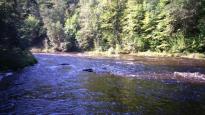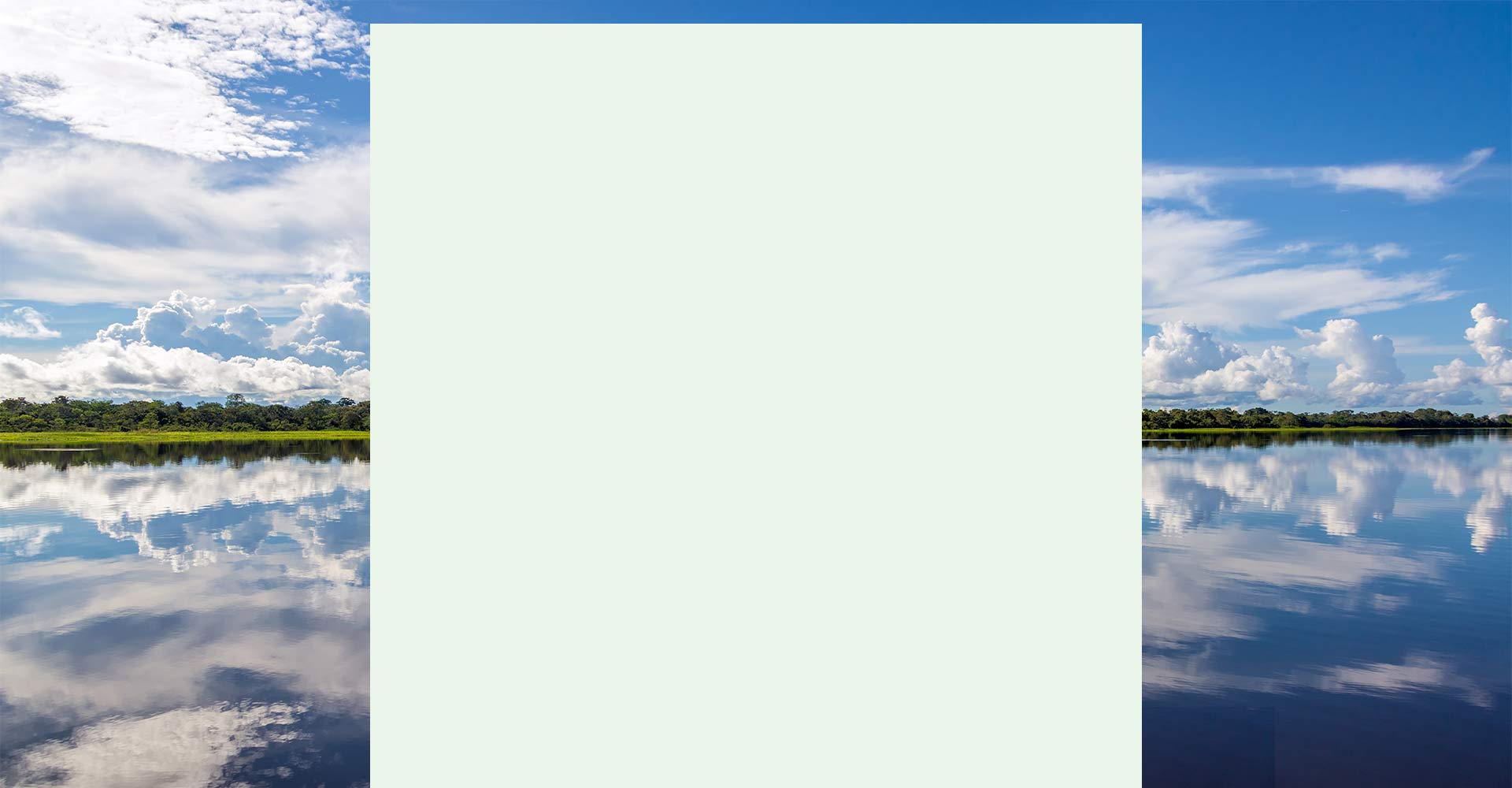
The Ogre River flows through Madona, Ērgļi, Vecpiebalga, Lielvārde and Ogre regions. The length of the river is 188 km, decline 222 m, the main tributaries – the Līčupe and the Aviekste flows into the Daugava River. Ogre is the third longest river in Latvia, none of its sections has ever been dredged. In 2003, the Latvian Nature Fund experts found large concentration of specially protected habitats and plant species in the Ogre River. In the river valley there are 15 Latvian specially protected habitats. Its banks are clearly directed against the north and south, so each bank has its own microclimate. While in one bank there is green grass and ephemerals are blossoming, in the other side the snow has not yet melted. In many parts the banks have dolomite outcrops: Kalnrēžu dolomite sandstone at Rembate and Ogre dolomite cliff at the former Ogre cardboard factory are protected geological objects.
Values of Ogre Natural park are unregulated Ogre River valley with its coast landscapes, diverse forests what in autumns are rich in berries and mushrooms, broad meadows, river rapids, steep banks, springs, secular stones, secular trees and various other natural elements that inspire and delight both residents of Natural Park and also its visitors. Special natural value is attached to Ogre manor stork colony, which is one of the biggest white stork nesting sites Latvia.
Šis ir populārākais Ogres upes mašruta posms, ja gribas izbaudīt Ogres upes krācītes.
Maršruts sākās Ērgļos. Ērgļos, apm. 300m virs šosejas tilta, ir HES aizsprosts. Tas ir 4m augsts. Laivas ūdenī ērtāk laist no derivācijas kanāla puses vai arī labajā krastā pie tilta.
Apmēram 6-7km pēc Ērgļiem Ogre ir lēna, tad sākās Brāžu krāces - labākais Ogres augšteces posms. Vidējais kritums krācēs ir ap 3-3.5m/km. No sportiskā viedokļa lielā ūdenī šīs krāces ir interesantas un dažādas. Krāču garums apmēram 10km.
Brāžu krāču beigu daļā ir bij. Emmas dzirnavu, tagad Vecogres HES aizsprosts (nejaukt ar bijušajām Roplaiņu dzirnavām), arī ap 4m augsts.
Vienas dienas maršrutu no Ērgļiem parasti beidz pie Kalnadalbu brasla - no šejienes ir visīsākais ceļš atpakaļ uz Ērgļiem - 15km (svarīgi, ja tur palikuši auto).
Šis ir populārākais Ogres upes mašruta posms, ja gribas izbaudīt Ogres upes krācītes.
Maršruts sākās Ērgļos. Ērgļos, apm. 300m virs šosejas tilta, ir HES aizsprosts. Tas ir 4m augsts. Laivas ūdenī ērtāk laist no derivācijas kanāla puses vai arī labajā krastā pie tilta.
Apmēram 6-7km pēc Ērgļiem Ogre ir lēna, tad sākās Brāžu krāces - labākais Ogres augšteces posms. Vidējais kritums krācēs ir ap 3-3.5m/km. No sportiskā viedokļa lielā ūdenī šīs krāces ir interesantas un dažādas. Krāču garums apmēram 10km.
Brāžu krāču beigu daļā ir bij. Emmas dzirnavu, tagad Vecogres HES aizsprosts (nejaukt ar bijušajām Roplaiņu dzirnavām), arī ap 4m augsts.
Vienas dienas maršrutu no Ērgļiem parasti beidz pie Kalnadalbu brasla - no šejienes ir visīsākais ceļš atpakaļ uz Ērgļiem - 15km (svarīgi, ja tur palikuši auto).
Nobraucienu pa Ogri var uzsākt visai augstu - apmēram jau no Līderes.
Cirstos Ogre jau ir liela upe.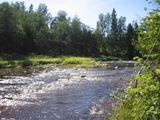 No Cirstiem līdz Ērgļiem Ogrē ir diezgan daudz sīku straujteču un krācīšu. Kritums - apm 1.5m/km; upes platums 10-15m.
No Cirstiem līdz Ērgļiem Ogrē ir diezgan daudz sīku straujteču un krācīšu. Kritums - apm 1.5m/km; upes platums 10-15m.
The Ogre River flows through Madona, Ērgļi, Vecpiebalga, Lielvārde and Ogre regions. The length of the river is 188 km, decline 222 m, the main tributaries – the Līčupe and the Aviekste flows into the Daugava River. Ogre is the third longest river in Latvia, none of its sections has ever been dredged. In 2003, the Latvian Nature Fund experts found large concentration of specially protected habitats and plant species in the Ogre River. In the river valley there are 15 Latvian specially protected habitats. Its banks are clearly directed against the north and south, so each bank has its own microclimate. While in one bank there is green grass and ephemerals are blossoming, in the other side the snow has not yet melted. In many parts the banks have dolomite outcrops: Kalnrēžu dolomite sandstone at Rembate and Ogre dolomite cliff at the former Ogre cardboard factory are protected geological objects.
Values of Ogre Natural park are unregulated Ogre River valley with its coast landscapes, diverse forests what in autumns are rich in berries and mushrooms, broad meadows, river rapids, steep banks, springs, secular stones, secular trees and various other natural elements that inspire and delight both residents of Natural Park and also its visitors. Special natural value is attached to Ogre manor stork colony, which is one of the biggest white stork nesting sites Latvia.
The Ogre River flows through Madona, Ērgļi, Vecpiebalga, Lielvārde and Ogre regions. The length of the river is 188 km, decline 222 m, the main tributaries – the Līčupe and the Aviekste flows into the Daugava River. Ogre is the third longest river in Latvia, none of its sections has ever been dredged. In 2003, the Latvian Nature Fund experts found large concentration of specially protected habitats and plant species in the Ogre River. In the river valley there are 15 Latvian specially protected habitats. Its banks are clearly directed against the north and south, so each bank has its own microclimate. While in one bank there is green grass and ephemerals are blossoming, in the other side the snow has not yet melted. In many parts the banks have dolomite outcrops: Kalnrēžu dolomite sandstone at Rembate and Ogre dolomite cliff at the former Ogre cardboard factory are protected geological objects.
Values of Ogre Natural park are unregulated Ogre River valley with its coast landscapes, diverse forests what in autumns are rich in berries and mushrooms, broad meadows, river rapids, steep banks, springs, secular stones, secular trees and various other natural elements that inspire and delight both residents of Natural Park and also its visitors. Special natural value is attached to Ogre manor stork colony, which is one of the biggest white stork nesting sites Latvia.
The Ogre River flows through Madona, Ērgļi, Vecpiebalga, Lielvārde and Ogre regions. The length of the river is 188 km, decline 222 m, the main tributaries – the Līčupe and the Aviekste flows into the Daugava River. Ogre is the third longest river in Latvia, none of its sections has ever been dredged. In 2003, the Latvian Nature Fund experts found large concentration of specially protected habitats and plant species in the Ogre River. In the river valley there are 15 Latvian specially protected habitats. Its banks are clearly directed against the north and south, so each bank has its own microclimate. While in one bank there is green grass and ephemerals are blossoming, in the other side the snow has not yet melted. In many parts the banks have dolomite outcrops: Kalnrēžu dolomite sandstone at Rembate and Ogre dolomite cliff at the former Ogre cardboard factory are protected geological objects.
Values of Ogre Natural park are unregulated Ogre River valley with its coast landscapes, diverse forests what in autumns are rich in berries and mushrooms, broad meadows, river rapids, steep banks, springs, secular stones, secular trees and various other natural elements that inspire and delight both residents of Natural Park and also its visitors. Special natural value is attached to Ogre manor stork colony, which is one of the biggest white stork nesting sites Latvia.
 Jaunogriņi
Jaunogriņi
 Cirstu manor
Cirstu manor
 Z/s "Jaun- Vītiņi" (Farm)
Z/s "Jaun- Vītiņi" (Farm)
 Dzirnavas
Dzirnavas
 Trijupes
Trijupes
 Sarkanie krasti
Sarkanie krasti
 Ērgļu profesionālā vidusskola
Ērgļu profesionālā vidusskola
 Old (Blaumaņa) cemetery
Old (Blaumaņa) cemetery
 Skanstes kalns - pilskalns
Skanstes kalns - pilskalns
 Ērgļu HES
Ērgļu HES
 Ērgļi
Ērgļi
 Vējkalna house
Vējkalna house
 Palīgs
Palīgs
 Estrāde
Estrāde
 Brāžu white water
Brāžu white water
 Akmeņupītes waterfall
Akmeņupītes waterfall
 Ergļi Railway Station
Ergļi Railway Station
 RAGNAR GLAMP ERGLI
RAGNAR GLAMP ERGLI
 Vecogres HES
Vecogres HES
 Ogre Manor Stork Colony
Ogre Manor Stork Colony
 Tiltiņš
Tiltiņš
 lkp Simtiņa
lkp Simtiņa
 Ogre Castle Mound
Ogre Castle Mound
 kkp Sumulda
kkp Sumulda
 lkp Līčupe
lkp Līčupe
 Pirts "Ogrēni"
Pirts "Ogrēni"
 Atpūtas vieta
Atpūtas vieta
 Ģērķi God's (Sacrificial) Hill
Ģērķi God's (Sacrificial) Hill
 lkp Taukātnīte
lkp Taukātnīte
 Dullā Dauka’s Grove
Dullā Dauka’s Grove
 Meņģeles muiža
Meņģeles muiža
 Rata Cross (Wheel cross) and Cross Stone
Rata Cross (Wheel cross) and Cross Stone
 Meņģeles tilts (V964)
Meņģeles tilts (V964)
 lkp Skolasupe
lkp Skolasupe
 lkp Rītupe
lkp Rītupe
 Tilts (V920)
Tilts (V920)
 kkp Makupīte
kkp Makupīte
 Kempings “Forsteri”
Kempings “Forsteri”
 Kämping “Krasti”
Kämping “Krasti”
 Dzērves avots
Dzērves avots
 Tilts (P32)
Tilts (P32)
 Tilts (P80)
Tilts (P80)
 Lēdmanes tilts (V972)
Lēdmanes tilts (V972)
 kkp Lobe
kkp Lobe
 Tilts (V996)
Tilts (V996)
 Atpūtas vieta
Atpūtas vieta
 Tiltiņš
Tiltiņš
 Atpūtas vieta
Atpūtas vieta
 Tiltiņš
Tiltiņš
 lkp Aviekste
lkp Aviekste
 Atpūtas vieta
Atpūtas vieta
 Jāņozols
Jāņozols
 Glāžšķūņa tilts (P8)
Glāžšķūņa tilts (P8)
 Sietiņi Devil's Stone
Sietiņi Devil's Stone
 Sala
Sala
 Kalnrēži Cliffs
Kalnrēži Cliffs
 Viesu nams “Indāni”
Viesu nams “Indāni”
 Tiltiņš
Tiltiņš
 Viesu nams “Sprīdīši”
Viesu nams “Sprīdīši”
 Jāņa Zviedra keramikas darbnīca
Jāņa Zviedra keramikas darbnīca
 Tiltiņš, lkp Ranka
Tiltiņš, lkp Ranka
 Tiltiņš
Tiltiņš
 Tiltiņš
Tiltiņš
 Atpūtas vieta
Atpūtas vieta
 Ogre Dolomite Steep Slope
Ogre Dolomite Steep Slope
 Ogres aizsprosts
Ogres aizsprosts
 lkp Norupīte
lkp Norupīte
 Gājēju tilts
Gājēju tilts
 Dzelzceļa tilts
Dzelzceļa tilts
 Ieteka Daugavā, tilts (A6)
Ieteka Daugavā, tilts (A6)
(+371) 28330027

Ropažu novads, Stopiņu pagasts, Līči, Poldera iela 10, “Sidrabozoli”
(+371) 28342558
(+371) 29247472




“Ziedoņi”, Jaunpiebalgas pagasts, Jaunpiebalgas novads, LV-4125
(+371) 25902905
(+371) 26567616



